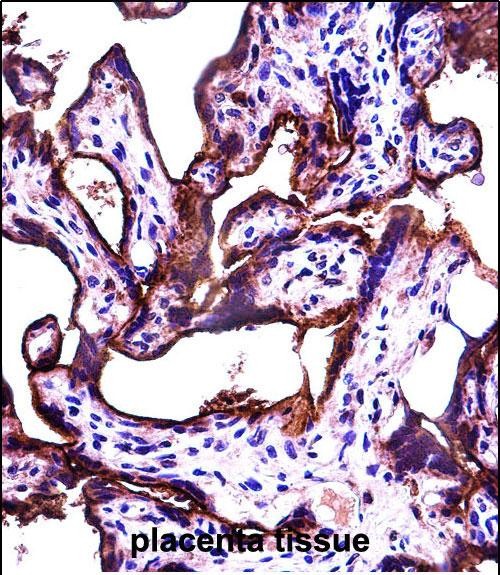ALPPL2 Antibody (N-term)
Affinity Purified Rabbit Polyclonal Antibody (Pab)
- SPECIFICATION
- CITATIONS: 2
- PROTOCOLS
- BACKGROUND

Application
| IHC-P, WB, E |
|---|---|
| Primary Accession | P10696 |
| Other Accession | NP_112603.2 |
| Reactivity | Human |
| Host | Rabbit |
| Clonality | Polyclonal |
| Isotype | Rabbit IgG |
| Calculated MW | 57377 Da |
| Antigen Region | 58-86 aa |
| Gene ID | 251 |
|---|---|
| Other Names | Alkaline phosphatase, placental-like, ALP-1, Alkaline phosphatase Nagao isozyme, Germ cell alkaline phosphatase, GCAP, Placental alkaline phosphatase-like, PLAP-like, ALPPL2, ALPPL |
| Target/Specificity | This ALPPL2 antibody is generated from rabbits immunized with a KLH conjugated synthetic peptide between 58-86 amino acids from the N-terminal region of human ALPPL2. |
| Dilution | IHC-P~~1:10~50 WB~~1:1000 E~~Use at an assay dependent concentration. |
| Format | Purified polyclonal antibody supplied in PBS with 0.09% (W/V) sodium azide. This antibody is purified through a protein A column, followed by peptide affinity purification. |
| Storage | Maintain refrigerated at 2-8°C for up to 2 weeks. For long term storage store at -20°C in small aliquots to prevent freeze-thaw cycles. |
| Precautions | ALPPL2 Antibody (N-term) is for research use only and not for use in diagnostic or therapeutic procedures. |
| Name | ALPG (HGNC:441) |
|---|---|
| Function | Alkaline phosphatase that can hydrolyze various phosphate compounds. |
| Cellular Location | Cell membrane; Lipid-anchor, GPI-anchor. |
| Tissue Location | Trace amounts in the testis and thymus, and in elevated amounts in germ cell tumors |

Provided below are standard protocols that you may find useful for product applications.
Background
There are at least four distinct but related alkaline phosphatases: intestinal, placental, placental-like, and liver/bone/kidney (tissue non-specific). The product of this gene is a membrane bound glycosylated enzyme, localized to testis, thymus and certain germ cell tumors, that is closely related to both the placental and intestinal forms of alkaline phosphatase.
References
Pelttari, K., et al. Arthritis Rheum. 54(10):3254-3266(2006)
Nakano, T., et al. Biochem. Biophys. Res. Commun. 341(1):33-38(2006)
Hillier, L.W., et al. Nature 434(7034):724-731(2005)
Le Du, M.H., et al. J. Biol. Chem. 277(51):49808-49814(2002)
Kozlenkov, A., et al. J. Biol. Chem. 277(25):22992-22999(2002)
If you have used an Abcepta product and would like to share how it has performed, please click on the "Submit Review" button and provide the requested information. Our staff will examine and post your review and contact you if needed.
If you have any additional inquiries please email technical services at tech@abcepta.com.














 Foundational characteristics of cancer include proliferation, angiogenesis, migration, evasion of apoptosis, and cellular immortality. Find key markers for these cellular processes and antibodies to detect them.
Foundational characteristics of cancer include proliferation, angiogenesis, migration, evasion of apoptosis, and cellular immortality. Find key markers for these cellular processes and antibodies to detect them. The SUMOplot™ Analysis Program predicts and scores sumoylation sites in your protein. SUMOylation is a post-translational modification involved in various cellular processes, such as nuclear-cytosolic transport, transcriptional regulation, apoptosis, protein stability, response to stress, and progression through the cell cycle.
The SUMOplot™ Analysis Program predicts and scores sumoylation sites in your protein. SUMOylation is a post-translational modification involved in various cellular processes, such as nuclear-cytosolic transport, transcriptional regulation, apoptosis, protein stability, response to stress, and progression through the cell cycle. The Autophagy Receptor Motif Plotter predicts and scores autophagy receptor binding sites in your protein. Identifying proteins connected to this pathway is critical to understanding the role of autophagy in physiological as well as pathological processes such as development, differentiation, neurodegenerative diseases, stress, infection, and cancer.
The Autophagy Receptor Motif Plotter predicts and scores autophagy receptor binding sites in your protein. Identifying proteins connected to this pathway is critical to understanding the role of autophagy in physiological as well as pathological processes such as development, differentiation, neurodegenerative diseases, stress, infection, and cancer.


